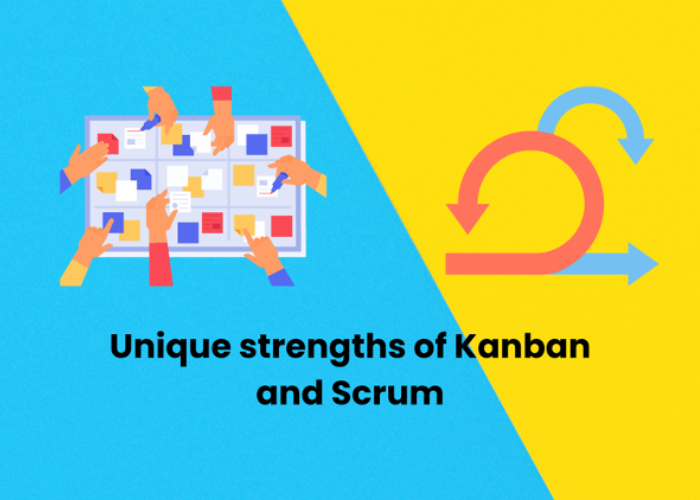Adopting agile practices has resulted in a dramatic improvement in team effectiveness. Kanban and Scrum, two of the most well-known Agile frameworks, stand out as adaptable methods that can be used in various contexts. In this post, we’ll compare and contrast two popular agile frameworks, Kanban Vs Scrum, to help you choose which is ideal for your team. Those who are serious about learning this methodology will also have their interest in a Scrum Course addressed.
Managing workflow using Kanban
The term “kanban” is of Japanese origin and means “visual card” or “signboard.” This technique succeeds because it emphasises a stable, continuous delivery strategy and promotes workflow visualisation. Kanban’s distinguishing features are as follows:
- The Kanban method may change its appearance to suit its environment. It is flexible enough to deal with either software development or non-technical procedures. Because of its adaptability, teams may quickly adjust to new priorities and integrate new ideas without restarting the whole process.
- Kanban relies heavily on a visual board that displays tasks in a simple, up-to-date format. The current work status is visible to all team members, encouraging open communication and responsibility. This graphic aids in the detection of inefficiencies and the implementation of ongoing improvements.
- Kanban sets and limits the number of active tasks at any one time. Team members will not be overburdened, and the pace will remain constant and controlled thanks to these limitations. Therefore, groups may maximise output without straining resources.
- The Lean principles upon which Kanban is founded include a focus on eliminating waste and increasing productivity. By reducing the amount of work being done at once, teams can better concentrate on producing results and avoiding the pitfalls of multitasking.
- Kanban promotes an atmosphere of constant development. Teams routinely assess their procedures and make fine-tuned adjustments based on data and feedback. This repeated method results in incremental gains in efficiency and quality.
Scrum: The Power of Sprints
The Scrum framework, on the other hand, is an Agile method that emphasises structure and uses iterative development cycles. Scrum emphasizes collaborative effort and flexibility. Let’s look at how Scrum is special:
- Scrum clearly defines the Product Owner, Scrum Master, and Development Team. Everyone will understand their roles, improving cooperation and decision-making.
- Sprints, the unit of time by which Scrum functions, typically last between two and four weeks. This time-bound method helps teams work efficiently and effectively towards defined objectives. Sprints are iterative development cycles that aim to produce a potentially shippable product increment at the end of each cycle.
- Daily Standups, Sprint Planning, Sprint Review, and Sprint Retrospective are just a few of the Scrum rituals that help facilitate open dialogue and constructive criticism. Participation in these rituals has been shown to improve teamwork and unity.
- Scrum is only as good as the Product Owner’s prioritised product backlog. With this backlog as the team’s authoritative source, the highest priority tasks will always be worked on first.
- Decisions in Scrum are based on empirical evidence and user input. Teams may use this method to swiftly adjust to shifting needs and market circumstances.
The Value of a Scrum Training Programme
As you learn more about Scrum, you may decide it’s a good fit for your team or company. However, a thorough familiarity with Scrum’s concepts, responsibilities, and procedures is necessary for successful adoption. Here’s where taking a Scrum training course would pay off.
Taking a Scrum training course has several advantages:
- A comprehensive Scrum course should guide students step-by-step through the process, from the initial planning stages to actual execution.
- You may validate your expertise as a Scrum practitioner by earning a certificate from one of the many available Scrum courses. There is a significant need in the labour market for certified Scrum specialists.
- The best Scrum courses will include interactive activities and simulations where you can put your newfound knowledge to the test.
- You’ll have access to knowledgeable teachers who can respond to your inquiries and provide advice based on their expertise.
- Scrum training events often attract diverse professionals from various fields, providing excellent possibilities for establishing and expanding professional connections.
Kanban vs. Scrum: The Choice Is Yours
There is no universally applicable solution to whether to use Kanban or Scrum. The demands of your team, the nature of your project, and your company’s values will all factor into your decision among the many Agile approaches.
If you value adaptability in your workflow and prefer a continuous delivery strategy, Kanban is the tool for you. When priorities shift regularly, and there’s a constant need to optimise flow and cut waste, Kanban shines.
If your team performs best with clear boundaries and regular rituals, Scrum is the framework for you. Projects that would do well with timed sprints, frequent inspections, and flexibility would do well with Scrum.
Conclusion
Kanban and Scrum have their own benefits that may boost your team’s efficiency and flexibility. It’s crucial to have a firm grasp of the fundamentals and subtleties of each framework before making a decision. The most important thing is to make sure that whichever method you choose (Kanban, for example, or a Scrum course to learn the Scrum framework) is in line with the needs of your team and the specifications of your project. Finding the correct Agile technology for your journey is more important than debating the relative merits of Kanban and Scrum.





